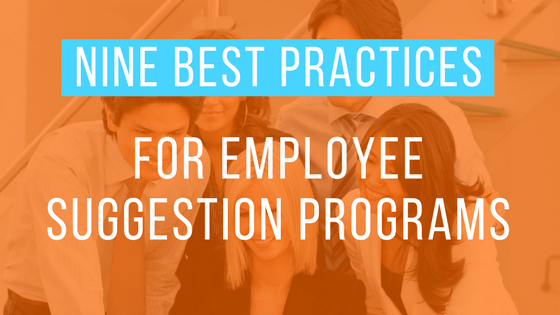Developing best practices for employee suggestion programs can have a positive impact on employee morale, overall corporate culture and an organization’s bottom line. Organizations can create positive changes that come straight from their employees, naturally increasing engagement and performance. Not to mention, your employees are in the trenches so they probably have all kinds of money-saving or revenue-building ideas.
In 2011-2012, for example, British Airways launched a staff suggestion program in response to a challenging economic environment. One employee’s suggestion was able to save them roughly $750,000 a year in fuel costs.
If you are going to ask employees for their opinions, you must follow the proper steps in building the program. If you create a program that lacks sophistication, tact or follow through, you can hurt your organization’s reputation and receive hostility from employees. The point of the suggestion program is to actually take the suggestions to heart and make sure that employees feel they are a valuable part of the organization.
Best Practices for Employee Suggestion Programs
Remember, your employees are your best assets — use them! Here are some steps to building your program:
1. Determine if a formal employee suggestion program is actually needed.
If you feel that suggestions are naturally flowing across the office or are being introduced at weekly staff meetings, an informal process may be the most beneficial. Instead of creating, for example, an employee suggestion box, try scheduling some brainstorming meetings or setting aside time in weekly meetings for employees to verbalize their ideas. If employees are already cultivating new ideas in meetings, dealing with them directly will be the most beneficial.
2. If an informal program doesn’t seem like the right way to go or your brainstorming sessions don’t seem to be working, then it is time to develop a formal program.
When developing a formal program, it is important to determine exactly what is blocking ideas in your organization. This way you can create a program that breaks down these barriers.
When developing a formal program, it is important to determine exactly what is blocking ideas in your organization. This way you can create a program that breaks down these barriers.
3. Obtain leadership buy-in.
Simply put, if employees don’t see senior leadership participating or advocating for the suggestion program, it is more likely to fail. If you need to obtain buy-in, share articles with your team on the benefits of employee suggestion programs.
4. Develop your formal plan.
Do some research and create a plan that you think will work best for your organization. It might help to look at other companies and see what they are doing in their programs.
5. Have some type of formal guidelines for employees to fill out with their suggestions.
Guiding them to answer questions like “Where did your idea stem from?” or “How do you believe this idea will benefit the organization?” can help prevent employees from venting their frustrations in unconstructive ways.
6. Develop a rewards program.
This doesn’t necessarily mean giving cash to each employee that has a suggestion. However, a small thank you card or note can go a long way. If you create small rewards, you create incentive and you receive more ideas. Another reward might be that for each suggestion, the employee’s name gets entered into a raffle for an Amazon gift card. Make sure that when you promote the reward, it will be for viable suggestions only, not for something like, “We should put an ice cream maker in the break room.”
7. Promote, promote, promote.
Once you have come up with your formal plan, make sure all employees across the organization (or at least in your branch) have access to it and are inspired to participate in it. Remember, it is not only your job to create the program, you are also responsible for inspiring employees to share their ideas. When you are promoting your program, try to include the program’s employee and organizational benefits and specify why you are implementing it. Also, make sure you launch the program in a creative way that creates buzz across the office. Get your senior leadership to help launch the program by promoting it in department meetings, and have the CEO create a small personal video about it.
8. Review the suggestions regularly.
Set up a cross-functional team to go over all the suggestions. It is important that employees at all levels across all departments are part of this group. This way, you can make sure all the ideas are evaluated correctly.
9. Follow through and create urgency.
If you take the time to develop this program and then don’t review and respond to the suggestions, you may make things worse. The faster you can respond to them, the better. You need to be proactive. If you don’t follow through, you will stop receiving suggestions, and you risk negative impact on employee engagement.
Now, there are a few things to keep in mind as you go. First, simplicity is key. Make sure it’s easy to submit ideas. If the process is overly complicated, employees probably won’t participate. Something else that will keep them from participating is backlash or perceived repercussions for being honest. So be sure to create a positive atmosphere around the program, and ensure the opportunity to remain anonymous is available.
I also recommend being creative with your program and how you market it. You might create an incentive program to participate, for example. Lastly — the most important part of developing any program or initiative that relies on employee feedback — is that you must follow through. So think of your employees as customers. If a customer has a suggestion or complaint, you would most likely do everything you can to make sure that customer feels heard and that any needed changes are made. Do the same with your employees. Respond to suggestions in a timely manner and provide feedback as to why something was or wasn’t implemented.
We’re all looking to maintain a sustainable competitive advantage, and your employees are yours. If they are engaged, they will do everything in their power to make your business successful.
This article originally appeared here on Forbes.com.
Let’s create a plan to build a positive workplace! | Invite Catherine to speak | Check out our webinar library



